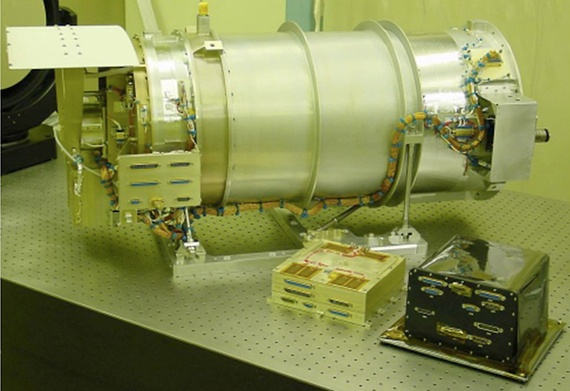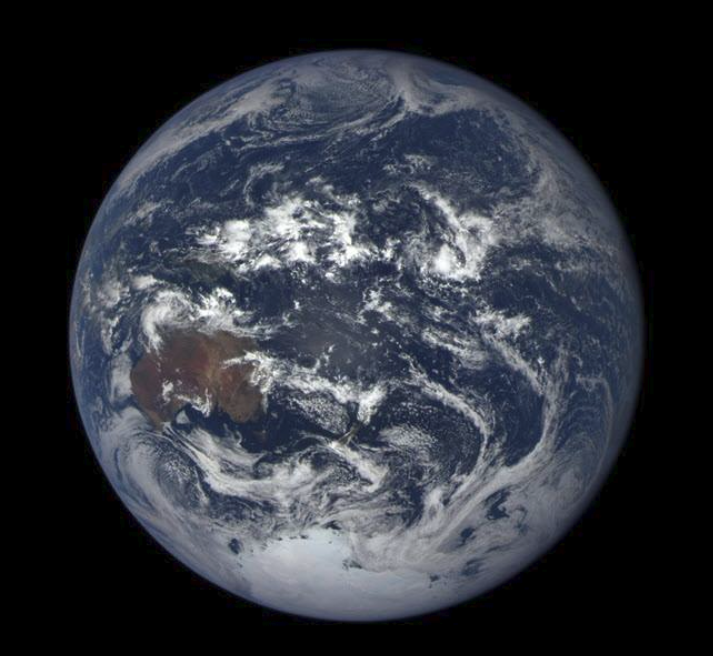File:DSCOVR w EPICcam, PlasMag & NISTAR.png: Difference between revisions
Siterunner (talk | contribs) No edit summary |
Siterunner (talk | contribs) No edit summary |
||
| (24 intermediate revisions by the same user not shown) | |||
| Line 2: | Line 2: | ||
'''''Feb 12, 2015 / DSCOVR-EPIC Is Launched with SpaceX''''' | |||
''The DSCOVR satellite with its EPIC cam, PlasMag & NISTAR instrument package is on the way... a million miles toward the Sun then 'parked' in orbit to send data of/to earth, incl first whole earth photos since 1972.'' | |||
::::::::::<big><big>'''''GreenPolicy360's in on the Mission'''''</big></big> | |||
'''''GreenPolicy360 assists NASA's DSCOVR mission team''''' | |||
'''''GreenPolicy360 steps up as [http://www.planetcitizen.org Planet Citizens] to aid the NASA/NOAA team deliver DSCOVR/EPIC data and imagery''''' | |||
[[File:Earth-NASA.jpg]] | |||
<big>''[[Planet Citizens, Planet Scientists]]''</big> | |||
<big><big>'''The DSCOVR Deep-Space Mission'''</big></big> | <big><big>'''The DSCOVR Deep-Space Mission'''</big></big> | ||
''From its origins, NASA has studied our planet in novel ways, using ingenious tools to | ''Via NASA: From its origins, NASA has studied our planet in novel ways, using ingenious tools to [https://www.greenpolicy360.net/w/File:You_can_manage_only_what_you_can_measure_Dr_David_Crisp,_OCO-2,_June_2014_m.jpg measure and monitor] physical processes at work — from beneath the crust to the edge of the atmosphere.'' | ||
''Most of all, NASA looks at [https://www.greenpolicy360.net/w/Category:Earth_System_Science Earth as a system], examining the cycles and processes — the water cycle, the carbon cycle, ocean circulation, the movement of heat — that interact and influence each other in a complex, dynamic dance across seasons and decades.'' | |||
''For all of the dynamism and detail we can observe from orbit, sometimes it is worth | ''For all of the dynamism and detail we can observe from orbit, sometimes it is worth [https://www.greenpolicy360.net/w/Earth_Science_Research_from_Space observing] and simply admiring Earth. Our planet is a beautiful, awe-inspiring place, and it is the only world most of us will ever know.'' | ||
[http://www.greenpolicy360.net/w/File:Earth-NASA.jpg <big><big><big>'''Earth''' 🌎 </big></big></big>] | |||
''' | <small>''Our Home Planet'' / ''Of all celestial bodies within reach or view, as far as we can see, out to the edge, the most wonderful and marvelous and mysterious is turning out to be our own planet earth. There is nothing to match it anywhere, not yet anyway. — Lewis Thomas''</small> | ||
'''DSCOVR w EPIC cam, PlasMag & NISTAR''' | |||
DSCOVR Earth science data is processed at NASA’s DSCOVR Science Operations Center and archived and distributed by NASA’s Atmospheric Science Data Center. | |||
Earth Polychromatic Imaging Camera (EPIC) | Earth Polychromatic Imaging Camera (EPIC) | ||
| Line 44: | Line 63: | ||
| | ||
Describing DSCOVR | |||
A: There are 2 Earth science instruments, and minor Pulse Height Analyzer instrument to study effect of space weather and cosmic rays on electronics. Solar wind particle and magnetic field data are deivered in real time to the NOAA Space Weather Prediction Center. As an operational spacecraft, the DSCOVR instrumentation is robust against outages caused by solar storms. Less significantly, DSCOVR provides fast cadence, once every 10 seconds data. | |||
DSCOVR Orbit | |||
A: | A: It takes 115 days to reach orbit in L-1 or Lagrange 1 point. NASA will likely hand over DSCOVR to NOAA in mid-summer timeframe. | ||
"Unlike personal cameras, EPIC will take images in 10 very narrow wavelength ranges," explains Adam Szabo, DSCOVR project scientist at NASA's Goddard Space Flight Center, Greenbelt, Maryland. | |||
"Combining these different wavelength images allows the determination of physical quantities like ozone, aerosols, dust and volcanic ash, cloud height, or vegetation cover. These results will be distributed as different publicly available data products allowing their combination with results from other missions." | |||
| | ||
| Line 103: | Line 114: | ||
'''For GreenPolicy360, the centerpiece of the mission will be the EPIC cam images of Earth 360''' | '''For GreenPolicy360, the centerpiece of the mission will be the EPIC cam images of Earth 360''' | ||
First whole earth pictures to be delivered from deep space [https://www.greenpolicy360.net/w/File:Blue_Marble_photo_-_Apollo_17.jpg since 1972] -- images we are looking to share as a life message of our home planet | |||
'''Planet Citizens we are -- together''' | '''Planet Citizens we are -- together''' | ||
| | ||
<big>''[[Earth Science Research from Space]]''</big> | :<big>''[[Earth Science Research from Space]]''</big> | ||
<big>''[[Earth and Space, Politics]]''</big> | :<big>''[[Earth and Space, Politics]]''</big> | ||
<big>''[[Climate News]]''</big> | :<big>''[[Climate News]]''</big> | ||
<big>''[[OCO-2]]''</big> | :<big>''[[OCO-2]]''</big> | ||
<big>''[[HelloEarth]]''</big> | :<big>''[[HelloEarth]]''</big> | ||
<big>''[[Earth Right Now]]''</big> | :<big>''[[Earth Right Now]]''</big> | ||
<big>''[[Earth Science Vital Signs]]''</big> | :<big>''[[Earth Science Vital Signs]]''</big> | ||
| | ||
::::::::::[https://www.greenpolicy360.net/w/File:DSCOVR_looks_back_at_earth_from_a_million_miles_away_m.jpg <big><big><big>'''''NASA's DSCOVR Mission'''''</big></big></big>] | |||
:: | ''[http://www.greenpolicy360.net/w/Category:NASA '''NASA's'''] [https://www.greenpolicy360.net/w/File:DSCOVR_looks_back_at_earth_from_a_million_miles_away_m.jpg '''DSCOVR/EPIC'''] website of Earth ... images now being made available online daily...'' | ||
''Unprecedented accompanying data and imagery available open source for #EarthScience and climate/atmospheric monitoring.'' | |||
'' | |||
''NASA Goddard communications to us, including this March 11th correspondence with GreenPolicy360, discussed calibrated data products to come from DSCOVR...'' | ''NASA Goddard communications to us, including this March 11th correspondence with GreenPolicy360, discussed calibrated data products to come from DSCOVR...'' | ||
| Line 151: | Line 149: | ||
:[[File:DSCOVR-2015-First Set of Images-test.png]] | |||
| |||
<big><big><big>'''Welcome to Daily Views of Our Home Planet'''</big></big></big> | |||
[https://www.greenpolicy360.net/w/File:DSCOVR_w_EPICcam,_PlasMag_%26_NISTAR.png ''The DSCOVR satellite with its EPIC cam, PlasMag & NISTAR instrument package]... is on a million mile journey and in approx four months, DSCOVR will "light up", be tested, and begin delivering data to Earth. In its historic mission, DSCOVR and its EPIC imaging system will begin sending near real-time images of the whole Earth... it has been many years since whole Earth images have been readily available...'' | |||
[ | [http://www.nasa.gov/press-release/nasa-satellite-camera-provides-epic-view-of-earth <big><big>'''DSCOVR 'Selfies' '''</big></big>] | ||
::• ''http://www.nesdis.noaa.gov/DSCOVR/'' | |||
::• ''http://epic.gsfc.nasa.gov/'' | |||
················································ | |||
[http://www.greenpolicy360.net/w/File:DSCOVR-EPIC_187_1003705_americas_dxm.png <big><big> | [http://www.greenpolicy360.net/w/File:DSCOVR-EPIC_187_1003705_americas_dxm.png <big><big>'''The Ultimate "Big Picture"'''</big></big>] | ||
::[http://www.nasa.gov/press-release/daily-views-of-earth-available-on-new-nasa-website/ '''''DSCOVR/EPIC News'''''] | ::[http://www.nasa.gov/press-release/daily-views-of-earth-available-on-new-nasa-website/ '''''DSCOVR/EPIC News'''''] | ||
················································ | |||
| Line 181: | Line 181: | ||
'''In Memory of the Apollo 17 1972 Image of Our Home Planet''' | '''In Memory of the Apollo 17 1972 Image of Our Home Planet''' | ||
* [http://www.greenpolicy360.net/w/Earthviews '''''Earthviews'''''] — [http://www.nasa.gov/content/celebrating-earths-beauty'''''Celebrating Earth's Beauty'''''] | |||
| | ||
[[File:Blue Marble photo - Apollo 17.jpg]] | [[File:Blue Marble photo - Apollo 17.jpg]] | ||
| Line 190: | Line 193: | ||
[[Category:Anthropocene]] | |||
[[Category:Atmospheric Science]] | [[Category:Atmospheric Science]] | ||
[[Category:Climate Policy]] | [[Category:Climate Policy]] | ||
[[Category:Democratization of Space]] | [[Category:Democratization of Space]] | ||
[[Category:Earth360]] | [[Category:Earth360]] | ||
[[Category:Earth Imaging]] | |||
[[Category:Earth Observations]] | [[Category:Earth Observations]] | ||
[[Category:Earth Science]] | [[Category:Earth Science]] | ||
[[Category:Ecology Studies]] | |||
[[Category:Environmental Security]] | [[Category:Environmental Security]] | ||
[[Category:EOS eco Operating System]] | [[Category:EOS eco Operating System]] | ||
| Line 203: | Line 208: | ||
[[Category:New Definitions of National Security]] | [[Category:New Definitions of National Security]] | ||
[[Category:New Space]] | [[Category:New Space]] | ||
[[Category:Online Education]] | |||
[[Category:Planet Citizen]] | |||
[[Category:Planet Citizens]] | [[Category:Planet Citizens]] | ||
[[Category:Planet Citizens, Planet Scientists]] | |||
[[Category:Strategic Demands]] | [[Category:Strategic Demands]] | ||
[[Category:Whole Earth]] | [[Category:Whole Earth]] | ||
Latest revision as of 12:48, 8 July 2023
<addthis />
Feb 12, 2015 / DSCOVR-EPIC Is Launched with SpaceX
The DSCOVR satellite with its EPIC cam, PlasMag & NISTAR instrument package is on the way... a million miles toward the Sun then 'parked' in orbit to send data of/to earth, incl first whole earth photos since 1972.
- GreenPolicy360's in on the Mission
GreenPolicy360 assists NASA's DSCOVR mission team
GreenPolicy360 steps up as Planet Citizens to aid the NASA/NOAA team deliver DSCOVR/EPIC data and imagery
Planet Citizens, Planet Scientists
The DSCOVR Deep-Space Mission
Via NASA: From its origins, NASA has studied our planet in novel ways, using ingenious tools to measure and monitor physical processes at work — from beneath the crust to the edge of the atmosphere.
Most of all, NASA looks at Earth as a system, examining the cycles and processes — the water cycle, the carbon cycle, ocean circulation, the movement of heat — that interact and influence each other in a complex, dynamic dance across seasons and decades.
For all of the dynamism and detail we can observe from orbit, sometimes it is worth observing and simply admiring Earth. Our planet is a beautiful, awe-inspiring place, and it is the only world most of us will ever know.
Our Home Planet / Of all celestial bodies within reach or view, as far as we can see, out to the edge, the most wonderful and marvelous and mysterious is turning out to be our own planet earth. There is nothing to match it anywhere, not yet anyway. — Lewis Thomas
DSCOVR w EPIC cam, PlasMag & NISTAR
DSCOVR Earth science data is processed at NASA’s DSCOVR Science Operations Center and archived and distributed by NASA’s Atmospheric Science Data Center.
Earth Polychromatic Imaging Camera (EPIC)
• http://www.nasa.gov/content/goddard/noaas-dscovr-to-provide-epic-views-of-earth/
• http://www.nesdis.noaa.gov/DSCOVR/pdf/DSCOVR%20-%20EPIC%20Instrument%20Info%20Sheet.pdf
• http://www.nesdis.noaa.gov/DSCOVR/
• http://mediaarchive.ksc.nasa.gov/search.cfm?cat=278%C2%A0%C2%A0%C2%A0
Describing DSCOVR
A: There are 2 Earth science instruments, and minor Pulse Height Analyzer instrument to study effect of space weather and cosmic rays on electronics. Solar wind particle and magnetic field data are deivered in real time to the NOAA Space Weather Prediction Center. As an operational spacecraft, the DSCOVR instrumentation is robust against outages caused by solar storms. Less significantly, DSCOVR provides fast cadence, once every 10 seconds data.
DSCOVR Orbit
A: It takes 115 days to reach orbit in L-1 or Lagrange 1 point. NASA will likely hand over DSCOVR to NOAA in mid-summer timeframe.
"Unlike personal cameras, EPIC will take images in 10 very narrow wavelength ranges," explains Adam Szabo, DSCOVR project scientist at NASA's Goddard Space Flight Center, Greenbelt, Maryland.
"Combining these different wavelength images allows the determination of physical quantities like ozone, aerosols, dust and volcanic ash, cloud height, or vegetation cover. These results will be distributed as different publicly available data products allowing their combination with results from other missions."
Q: Have modifications been made to EPIC to enhance its Earth science measurements?
A: Original EPIC instrument concept is similar to current configuration. Improvements were made in all narrow-length wavelength bands to reduce stray light and to add new cloud height measurements. Ozone, aerosols, cloud amount, and vegetation were all in original design. Wavelength changes were made based on other earth-observing satellites over the last 15 years. Earth science data will be obtained about every 2 hours and downloaded to earth whenever the large Wallops Island antenna is in view.
The DSCOVR mission is a partnership between NOAA, NASA, and the U.S. Air Force. NOAA will operate DSCOVR from its NOAA Satellite Operations Facility in Suitland, Maryland, and process data at NOAA's Space Weather Prediction Center (SWPC) in Boulder, Colorado, for distribution to users within the United States and around the world. The data will be archived at NOAA’s National Geophysical Data Center also in Boulder. The U.S. Air Force is providing the launch vehicle for the DSCOVR mission and the responsibility for all launch vehicle associated mission assurance.
NASA received funding from NOAA to refurbish the DSCOVR spacecraft and its solar wind instruments, develop the ground segment, and manage launch and activation of the satellite. The Air Force funds and oversees the launch services for DSCOVR. DSCOVR will also host NASA-funded secondary sensors for Earth and space science observations. The Earth science data will be processed at NASA’s DSCOVR Science Operations Center and archived and distributed by NASA’s Atmospheric Science Data Center.
DSCOVR and EPIC... For many Earth scientists, the centerpiece of the satellite is the National Institute of Standards Advanced Radiometer, or NISTAR, named for the Maryland-based government laboratory that designed it. The apparatus was built to shed light on Earth’s “radiation balance”—the radiation we receive from our sun minus the radiation we reflect back into space. The difference is retained by our planet as heat, and is calculated by measuring Earth’s reflectivity, called the albedo. Data showing whether Earth’s albedo is decreasing, meaning the atmosphere is retaining more heat because of greenhouse gases or other reasons, could be a significant piece of the climate puzzle.
What was revolutionary wasn’t the basic technology for tracking albedo — it was measuring it from the million-mile perspective out at L1.
Most satellites circle the planet at about one-thousandth of that distance, so their readings encompass only a small slice of land, a view that shifts rapidly as they circle the planet every two hours or so. Different climate zones — ice caps, deserts, tropical forests—have different reflectivities, independent of the atmosphere, which needs to be factored in to the overall measurement; it’s virtually impossible to create a whole-Earth portrait from a deck of low-orbit snapshots.
“By the time you stitch together all the separate bits of data, the margin of error is too large to be useful,” Asrar says.
“DSCOVR, on the other hand, would be like having a thermometer for the whole planet.” It’s not a perfect gauge, NASA’s Szabo cautions.
“Earth is…a sphere that reflects light in all directions. So a measurement from any one point will not be the final word. But it will still be very important for the conversation about climate change.”
http://www.greenpolicy360.net/w/File:EPIC_cam.jpg
EarthPOV
For GreenPolicy360, the centerpiece of the mission will be the EPIC cam images of Earth 360
First whole earth pictures to be delivered from deep space since 1972 -- images we are looking to share as a life message of our home planet
Planet Citizens we are -- together
NASA's DSCOVR/EPIC website of Earth ... images now being made available online daily...
Unprecedented accompanying data and imagery available open source for #EarthScience and climate/atmospheric monitoring.
NASA Goddard communications to us, including this March 11th correspondence with GreenPolicy360, discussed calibrated data products to come from DSCOVR...
The individual 10 different wavelength EPIC data will be (and is now being) served from the Atmospheric Science Data Center (ASDC) at Langley.
Welcome to Daily Views of Our Home Planet
The DSCOVR satellite with its EPIC cam, PlasMag & NISTAR instrument package... is on a million mile journey and in approx four months, DSCOVR will "light up", be tested, and begin delivering data to Earth. In its historic mission, DSCOVR and its EPIC imaging system will begin sending near real-time images of the whole Earth... it has been many years since whole Earth images have been readily available...
················································
················································
"Blue Marble"
In Memory of the Apollo 17 1972 Image of Our Home Planet
○
File history
Click on a date/time to view the file as it appeared at that time.
| Date/Time | Thumbnail | Dimensions | User | Comment | |
|---|---|---|---|---|---|
| current | 00:46, 13 February 2015 |  | 1,219 × 785 (1.49 MB) | Siterunner (talk | contribs) | Category:Green Graphics Category:Earth Science Category:Earth360 |
You cannot overwrite this file.
File usage
The following 2 pages use this file:
- Anthropocene
- Atmospheric Science
- Climate Policy
- Democratization of Space
- Earth360
- Earth Imaging
- Earth Observations
- Earth Science
- Ecology Studies
- Environmental Security
- EOS eco Operating System
- Green Graphics
- NASA
- New Definitions of National Security
- New Space
- Online Education
- Planet Citizen
- Planet Citizens
- Planet Citizens, Planet Scientists
- Strategic Demands
- Whole Earth
- Climate Change
- Cryosphere
- Geophysics and Geochemistry
- Mineralogy
- Geology
- Geophysics
- Hydrology
- Natural Resources
- Ocean Science
- Planetary Science
- Space Science and Space Physics



